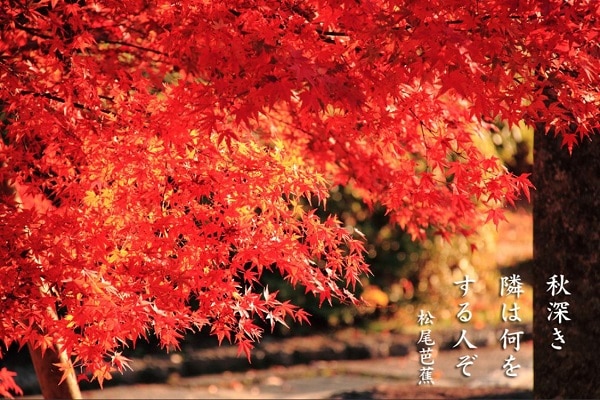Introduction to Traditional Japanese Poetry Haiku
BY KAORI NOMURA
Haiku is a short poem originated in the 16th century Japan. Traditional haiku is composed following a fixed format called yuukiteikei 有季定型. As a general rule, historical kana orthography, which is the old kana system, has to be used in haiku and the yuukiteikei is characterized by three features. Let’s have a look at these features through some examples below.

Example haiku
Poet: Matsuo Bashou 松尾芭蕉
閑かさや 岩にしみ入る 蝉の声
Shizukasa ya / Iwa ni shimiiru / Semi no koe
Ah, tranquility! / Penetrating the very rock / A cicada’s voice
[Trans. Helen Craig Mccallough]
#2. 5-7-5 (go-shichi-go)
Haiku has a format of san-ku juu-shichi-on 3句17音. That means it has a total of 17-on (17 syllables) and is composed of 5-7-5 (go-shichi-go) syllables. Each phrase is called ku 句 – the first phrase is called ik-ku 1句 (sho-ku 初句), the second ni-ku 2句, and the last san-ku 3句 (kek-ku 結句).
Let’s look at the 5-7-5 format using the haiku example above:
Shi/zu/ka/sa/ya (5 syllables) ← ik-ku 1句 (sho-ku 初句)
I/wa/ni/shi/mi/i/ru (7 syllables) ← ni-ku 2句
Se/mi/no/ko/e (5 syllables) ← san-ku 3句 (kek-ku 結句)
#3. Kireji 切れ字 (punctuation words)
Kireji is a punctuation word which has a function to complete the expression of the phrase in a limited amount of words. 「や ya」「かな kana」「けりkeri」are common kireji 切れ字 used in the middle of the phrase or the end of the phrase. The use of kireji brings extra meanings or special emotions of the poet so it is an essential technique in haiku composition. In English, it could be translated as “Ah!”, or the punctuation “!” or “-“.
Famous Haiku Poets and Verses
Below are some famous haiku by Japan’s most renowned haiku poets.
- Poet: Matsuo Bashou 松尾芭蕉
古池や 蛙飛び込む 水の音
Furuike ya / Kawazu tobikomu / Mizu no oto
Old pond / Frogs jumped in / Sound of water
[Trans.小泉八雲 = Lafcadio Hearn] - Poet: Yosa Buson 与謝蕪村
菜の花や 月は東に 日は西に
Nanohana ya / Tsuki wa higashi ni / Hi wa nishi ni
Flowers of rape / The moon in the east / The sun in the west
[Trans. R.H.Blyth] - Poet: Masaoka Shiki 正岡子規
柿くへば 鐘が鳴るなり 法隆寺
Kaki kueba / Kane ga naru nari / Horyu-ji
Biting into a persimmon / A bell resounds / Horyu-ji
[Trans.The Shiki Museum] - Poet: Matsuo Bashou 松尾芭蕉
秋深き 隣は何を する人ぞ
Aki fukaki / Tonari wa nani wo / Suru hito zo
Deep autumn – / My neighbor / How does he live, I wonder?
[Trans. R.H.Blyth] - Poet: Kobayashi Issa小林一茶
やせ蛙 まけるな一茶 ここにあり
Yasegaeru / Makeruna Issa / Koko ni ari
Scrawny frog / Hang tough! / Issa is here
[Trans. David G. Lanoue]
Haiku has fascinated many people in the world and many famous haiku verses have been translated into English by famous writers. The translations have been done differently and it seems difficult to convey the minute nuance in English.
It is both fun and challenging trying to apply what you have learned in your Japanese class into haiku writing. There are many haiku competitions held regularly both in Japan and overseas. Submissions are usually available in Japanese or English, such as the International Kusamakura Haiku Competition, The Mainichi Haiku Contest, and the Ito En Oi Ocha Shinhaiku Contest.



